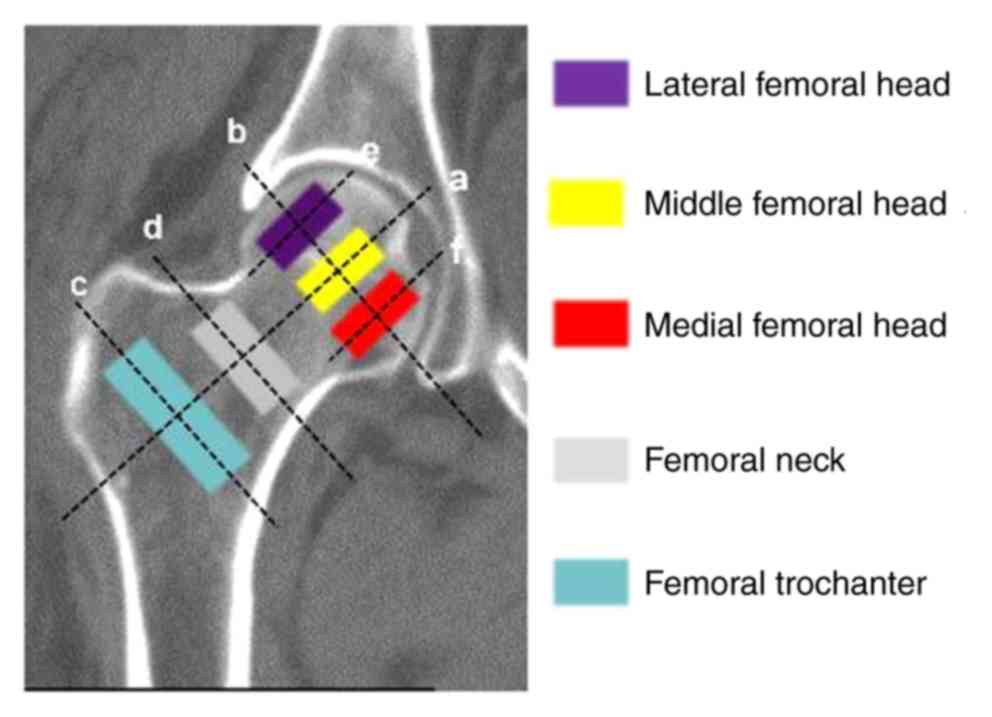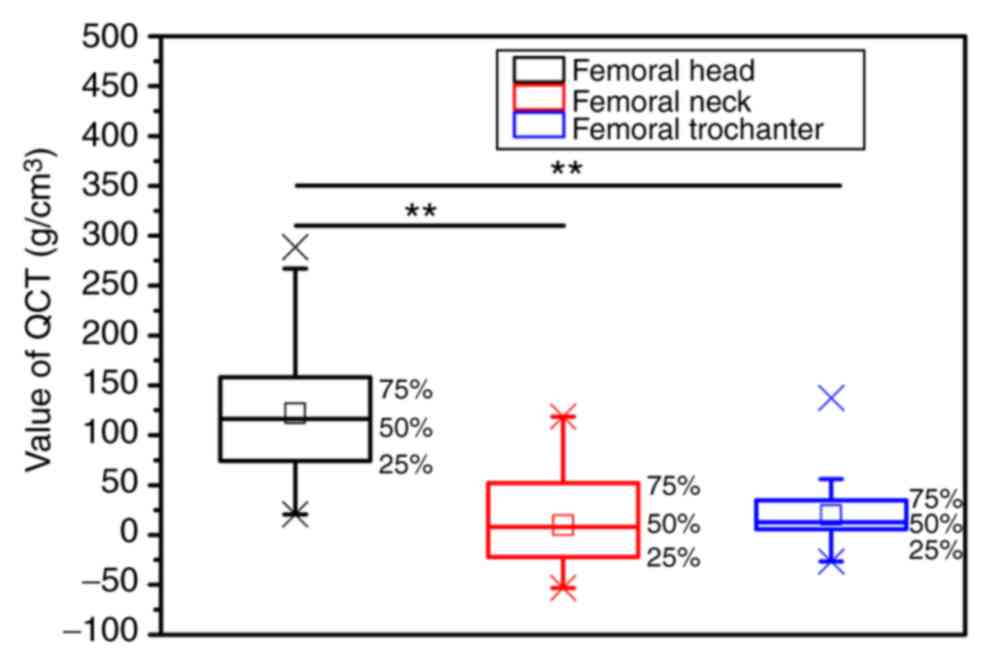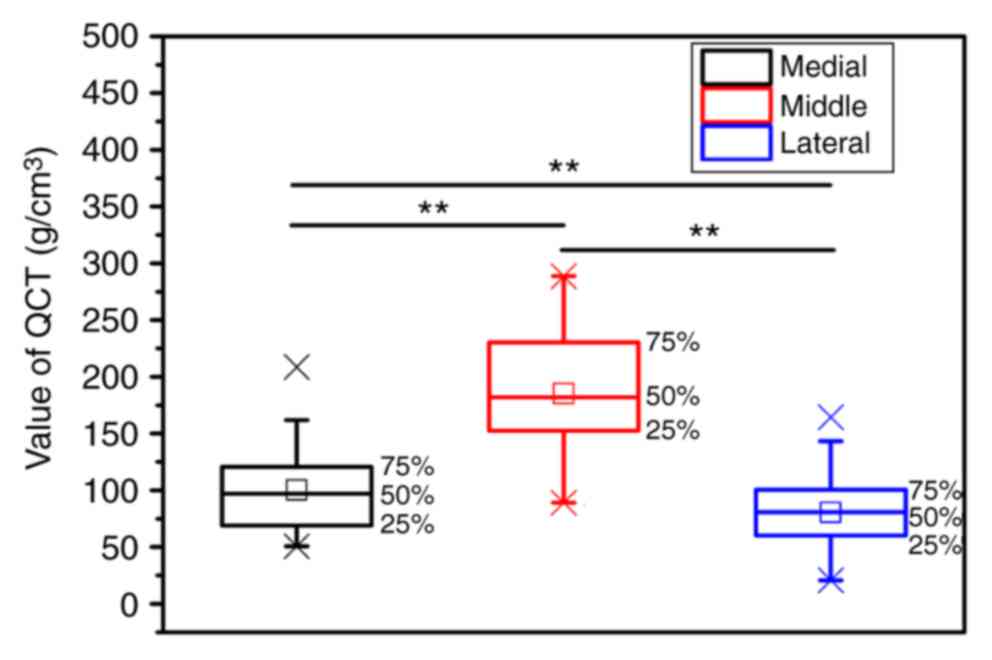|
1
|
Mundi S, Pindiprolu B, Simunovic N and
Bhandari M: Similar mortality rates in hip fracture patients over
the past 31 years. Acta Orthop. 85:54–59. 2014.PubMed/NCBI View Article : Google Scholar
|
|
2
|
Kristek D, Lovric I, Kristek J, Biljan M,
Kristek G and Sakic K: The proximal femoral nail antirotation
(PFNA) in the treatment of proximal femoral fractures. Coll
Antropol. 34:937–940. 2010.PubMed/NCBI
|
|
3
|
Steiner JA, Ferguson SJ and Van Lenthe GH:
Computational analysis of primary implant stability in trabecular
bone. J Biomech. 48:807–815. 2015.PubMed/NCBI View Article : Google Scholar
|
|
4
|
Grechenig S, Gänsslen A, Gueorguiev B,
Berner A, Müller M, Nerlich M and Schmitz P: PMMA-augmented SI
screw: A biomechanical analysis of stiffness and pull-out force in
a matched paired human cadaveric model. Injury. 46 (Suppl
4):S125–S128. 2015.PubMed/NCBI View Article : Google Scholar
|
|
5
|
Schiuma D, Plecko M, Kloub M, Rothstock S,
Windolf M and Gueorguiev B: Influence of peri-implant bone quality
on implant stability. Med Eng Phys. 35:82–87. 2013.PubMed/NCBI View Article : Google Scholar
|
|
6
|
Van Rietbergen B, Van Huiskes R, Eckstein
F and Rüegsegger P: Trabecular bone tissue strains in the healthy
and osteoporotic human femur. J Bone Miner Res. 18:1781–1788.
2010.PubMed/NCBI View Article : Google Scholar
|
|
7
|
Broderick JM, Bruce-Brand R, Stanley E and
Mulhall KJ: Osteoporotic hip fractures: The burden of fixation
failure. ScientificWorldJournal. 2013(515197)2013.PubMed/NCBI View Article : Google Scholar
|
|
8
|
Born CT, Karich B, Bauer C, von Oldenburg
G and Augat P: Hip screw migration testing: First results for hip
screws and helical blades utilizing a new oscillating test method.
J Orthop Res. 29:760–766. 2011.PubMed/NCBI View Article : Google Scholar
|
|
9
|
Bonnaire F, Weber A, Bösl O, Eckhardt C,
Schwieger K and Linke B: ‘Cutting out’ in pertrochanteric
fractures-problem of osteoporosis? Unfallchirurg. 110:425–432.
2007.(In German). PubMed/NCBI View Article : Google Scholar
|
|
10
|
Audigé L, Hanson B and Swiontkowski MF:
Implant-related complications in the treatment of unstable
intertrochanteric fractures: Meta-analysis of dynamic screw-plate
versus dynamic screw-intramedullary nail devices. Int Orthop.
27:197–203. 2003.PubMed/NCBI View Article : Google Scholar
|
|
11
|
Konstantinidis L, Papaioannou C, Blanke P,
Hirschmüller A, Südkamp N and Helwig P: Failure after
osteosynthesis of trochanteric fractures. Where is the limit of
osteoporosis? Osteoporos Int. 24:2701–2706. 2013.PubMed/NCBI View Article : Google Scholar
|
|
12
|
Kang SR, Bok SC, Choi SC, Lee SS, Heo MS,
Huh KH, Kim TI and Yi WJ: The relationship between dental implant
stability and trabecular bone structure using cone-beam computed
tomography. J Periodontal Implant Sci. 46:116–127. 2016.PubMed/NCBI View Article : Google Scholar
|
|
13
|
Kuzyk PR, Zdero R, Shah S, Olsen M,
Waddell JP and Schemitsch EH: Femoral head lag screw position for
cephalomedullary nails: A biomechanical analysis. J Orthop Trauma.
26:414–421. 2012.PubMed/NCBI View Article : Google Scholar
|
|
14
|
Goffin JM, Pankaj P and Simpson AH: The
importance of lag screw position for the stabilization of
trochanteric fractures with a sliding hip screw: A subject-specific
finite element study. J Orthop Res. 31:596–600. 2013.PubMed/NCBI View Article : Google Scholar
|
|
15
|
Bessho M, Ohnishi I, Matsumoto T, Ohashi
S, Matsuyama J, Tobita K, Kaneko M and Nakamura K: Prediction of
proximal femur strength using a CT-based nonlinear finite element
method: Differences in predicted fracture load and site with
changing load and boundary conditions. Bone. 45:226–231.
2009.PubMed/NCBI View Article : Google Scholar
|
|
16
|
Watts NB: Fundamentals and pitfalls of
bone densitometry using dual-energy X-ray absorptiometry (DXA).
Osteoporos Int. 15:847–854. 2004.PubMed/NCBI View Article : Google Scholar
|
|
17
|
Shim VB, Pitto RP and Anderson IA:
Quantitative CT with finite element analysis: Towards a predictive
tool for bone remodelling around an uncemented tapered stem. Int
Orthop. 36:1363–1369. 2012.PubMed/NCBI View Article : Google Scholar
|
|
18
|
Black DM, Bouxsein ML, Marshall LM,
Cummings SR, Lang TF, Cauley JA, Ensrud KE, Nielson CM and Orwoll
ES: Osteoporotic Fractures in Men (MrOS) Research Group: Proximal
femoral structure and the prediction of hip fracture in men: A
large prospective study using QCT. J Bone Miner Res. 23:1326–1333.
2010.PubMed/NCBI View Article : Google Scholar
|
|
19
|
Cheng X, Li J, Lu Y, Keyak J and Lang T:
Proximal femoral density and geometry measurements by quantitative
computed tomography: Association with hip fracture. Bone.
40:169–174. 2007.PubMed/NCBI View Article : Google Scholar
|
|
20
|
Cheng XG, Lowet G, Boonen S, Nicholson PH,
Brys P, Nijs J and Dequeker J: Assessment of the strength of
proximal femur in vitro: Relationship to femoral bone mineral
density and femoral geometry. Bone. 20:213–218. 1997.PubMed/NCBI View Article : Google Scholar
|
|
21
|
Cody DD, Divine GW, Nahigian K and
Kleerekoper M: Bone density distribution and gender dominate
femoral neck fracture risk predictors. Skeletal Radiol. 29:151–161.
2000.PubMed/NCBI View Article : Google Scholar
|
|
22
|
Cui WQ, Won YY, Baek MH, Lee DH, Chung YS,
Hur JH and Ma YZ: Age-and region-dependent changes in
three-dimensional microstructural properties of proximal femoral
trabeculae. Osteoporos Int. 19:1579–1587. 2008.PubMed/NCBI View Article : Google Scholar
|
|
23
|
Dendorfer S, Maier HJ, Taylor D and Hammer
J: Anisotropy of the fatigue behaviour of cancellous bone. J
Biomech. 41:636–641. 2008.PubMed/NCBI View Article : Google Scholar
|
|
24
|
Baumgaertner MR, Curtin SL, Lindskog DM
and Keggi JM: The value of the tip-apex distance in predicting
failure of fixation of peritrochanteric fractures of the hip. J
Bone Joint Surg Am. 77:1058–1064. 1995.PubMed/NCBI View Article : Google Scholar
|
|
25
|
Jang IG and Kim IY: Computational study of
wolff's law with trabecular architecture in the human proximal
femur using topology optimization. J Biomech. 41:2353–2361.
2008.PubMed/NCBI View Article : Google Scholar
|
|
26
|
Li B and Aspden RM: Material properties of
bone from the femoral neck and calcar femorale of patients with
osteoporosis or osteoarthritis. Osteoporos Int. 7:450–456.
1997.PubMed/NCBI View Article : Google Scholar
|

















